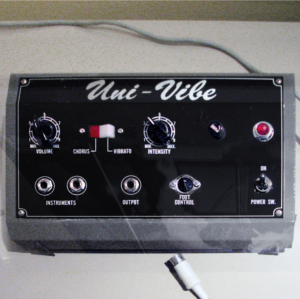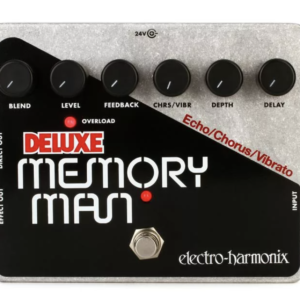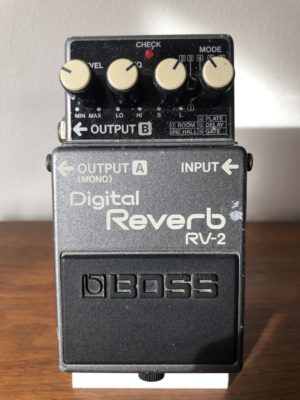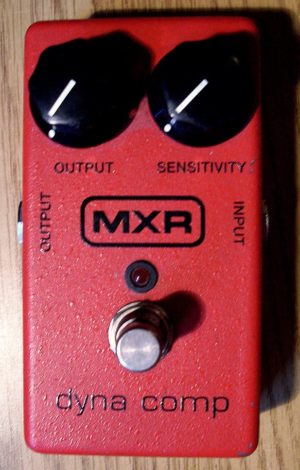6 Famous Guitar Pedals You Should Know

When the electric guitars first hit the scene in the late 1930s, a new world of possibilities opened up. Effectively, a novel instrument was born. And just like you could mute a trumpet, or prepare a piano, the sounds coming from an electric guitar could be manipulated too. This is where (you guessed it) electric guitar pedals made names for themselves.
The concept of compact guitar effects pedals surfaced as early as the late 1940s. However, the tools themselves didn’t become commercially viable until the 1960s. And since then, countless guitar pedals have come to market and found popularity – some of them making more ‘noise’ than others (pun intended). So, here are 6 famous guitar pedals you should know about!

1. Maestro FZ-1 Fuzz-Tone Guitar Pedal
Technically, the DeArmond Trem Trol 800 is considered to be the first guitar pedal ever created. But, Gibson was the first to make a stomp box that was suitable for commercial distribution! The Maestro FZ1 Fuzz-Tone became quite popular after was used to record The Rolling Stones‘ 1965 superhit, “(I Can’t Get No) Satisfaction.” Though this model was discontinued in the 90s, its distant successor was released in 2022. You can find the Fuzz-Tone FZ-M for under $150 on Sweetwater!
 2. Vox V846 Wah Guitar Pedal
2. Vox V846 Wah Guitar Pedal
If you have ever listened to psychedelic rock or funk music, chances are you’ve heard the distinctive sounds of the ‘wah’ effect. The actual ‘wah’ sound happens when a moveable EQ band pass filter with a resonant peak moves up and down the frequency spectrum. The position of the peak is controlled by a ‘wah’ pedal’s seesaw foot switch. In the 1960s, VOX became a frontrunner in the ‘wah’ guitar pedal market with its unrivaled V846 model. This pedal achieved notoriety after guitar aficionados discovered it was Jimi Hendrix‘s preference during his 1969 Woodstock appearance. Though vintage V846 models are limited, VOX continues to produce a successor model, the V846-HW. You can find this pedal for under $250 on Sweetwater!

3. Uni-Vibe Phase Guitar Pedal
Some say it’s a chorus pedal, and some day it’s a vibrato pedal. Although it emulates both of these effects, the legendary Uni-Vibe was actually a versatile phaser (phase-shifting) pedal. Many speculate the effects this pedal produces were inspired by the oscillatory textures of a Leslie speaker. Pairing well with other effects like fuzz and reverb, the Uni-Vibe was a popular tool amongst 60s and 70s musicians, including Jimi Hendrix and Pink Floyd. Today, many pedal manufacturers offer their own spins on the classic Uni-Vibe sound. You can find one by MXR for under $130 on Sweetwater!
 4. Memory Man Delay Guitar Pedal
4. Memory Man Delay Guitar Pedal
The original methods for achieving delay or echo effects involved using analog hardware. Magnetic tape machines were used to create real-time copies of an original input signal that was played back at a predetermined rate. The problem guitarists found was that this hardware was typically too bulky to be used reliably on stage. A compact console that could produce this effect became a reality with the use of solid-state technology. This is where the pedal manufacturer, Electro-Harmonix made a name for itself. The Deluxe Memory Man pedal became an essential tool for famous guitarists such as The Edge, Chris Cornell, and Jamie Cook. Since the pedal’s release in the 1970s, Electro-Harmonix has reissued several different versions of the pedal. This includes a few you can find on Sweetwater!

5. Boss RV-2 Reverb Guitar Pedal
Reverb is an effect you can experience in every day life. The cavernous sounds of a church, or the reflections you hear when singing in the shower are both examples of reverberation. In the audio world, this effect was originally recreated in a few different ways: metal springs and plates were often used to emulate the sound of a confined space. Digital reverb technology simplified all of this when it revolutionized the market in the 1970s. Then, in 1987, Boss revealed its compact RV-2 model that captured the textures of many legacy styles of reverb. This pedal quickly became popular with guitarists and has since become a benchmark for other guitar pedal manufacturers. You can find Boss’ latest iteration of this pedal, the RV-6 for under $180 on Sweetwater!

6. MXR Dyna Comp Guitar Pedal
Though technically not the first of its kind, the MXR Dyna Comp became one of the earliest, and most popular, compression stomp boxes after its 1972 debut. Compression was originally a tool that telephone manufacturers and record producers used to control the dynamic range audio. But guitarists eventually fell in love with the sonic qualities and ‘color’ that some compressors brought out of their amplifiers. The MXR Dyna Comp is one guitar pedal that has persisted throughout the years. You can find one for under $100 at Sweetwater!
Excited to look at some new gear? Find all kinds of great gear deals over at Sweetwater.com.
For guitar lessons that teach you how to use effects like these, check out JamPlay.com! JamPlay has over 450 guitar courses from 120+ instructors, LIVE daily instruction, and online guitar lessons tailored to every skill level, music genre, and playing style. Click here to learn more.
Share this
Become a JamPlay member for unlimited access to 7000+ guitar lessons and 120+ artists and instructors. View membership plans ›


